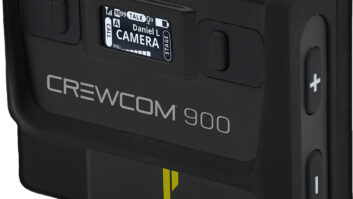Something old, something new at Ericsson Stadium: Modern technology appliedto old concepts makes spectacular sound.
Jul 1, 1997 12:00 PM,
Sam Gidren
Since their inception, stadium audio systems have encom-passed every typeof loud-speaker layout, with the possible exception of a seat-back system.Ring clusters, distributed systems, end-zone cluster systems, a centralcluster or two, and variations or combinations of these abound in stadiathroughout the world. These high-powered systems traditionally use largenumbers of one-box systems, separate components, or combinations of the twoto provide intelligible sound and often music to tens of thousands ofpeople in each venue. Along with the sheer numbers of devices in thesesystems come racks and racks of amplifiers, often miles of wiring, and somemeans of exercising control over the multitude of equipment that mightotherwise be difficult even with top technical expertise in the driver’sseat.
In the early days of PA systems, the only way to provide stadium-size soundwas to use highly efficient loudspeakers, all reproducing the same limitedfrequency range. When you only had amplifiers rated at 10 W or so, therewas no other choice. Requirements have changed in many installations,spurred on by music and sound-effect reproduction and audienceexpectations. The highly charged atmospheres of the sporting events,competition for the audience dollar and spectacle-style event programmingare no longer supported by a bank of multicell voice horns. An example ofthis new design philosophy is Ericsson Stadium, home of the CarolinaPanthers.
As with many stadia, Ericsson Stadium’s sound system must provide bothvoice and music to sports fans with a penchant for generating considerablesound levels on their own. The system is used not only for informationalcommunications but as an active part of the attendees’ experience. Bothmusic and commentary are piped through the system to encourage an addedlevel of excitement from the crowd, to literally get them dancing in theaisles in support of their teams.
To successfully employ this type of audio system usage requires deliveringhigh SPLs over a wide bandwidth with intelligibility, clarity, impact andhigh-quality reproduction to every seat. At Ericsson Stadium, theloudspeaker design has reinforced the premise that less can be more.
New sound for a new teamThe NFL has undergone many changes in the past few years, with a number ofteams moving to other cities and the addition of two new teams. Becausethese teams expand the league, they are called, for obvious reasons,expansion teams. Unfortunately, the name expansion team carries a certainstigma. Unlike aged organizations, such as the Pittsburgh Steelers or GreenBay Packers, which have been around since the dark ages of professionalfootball, an expansion team is the new kid in town and usually regardedaccordingly. In a nutshell, this means it usually receives no credibilityas a full-fledged professional team. The cities they occupy rarely have hada similar team, so their fans are neophytes. Nor have the fans establishedanything like the team loyalties characteristic of crazed football fanslike those of Green Bay sporting their cheese-head chapeaux.
A case in point is the Carolina Panthers. First of all, Charlotte is notknown as a national sports mecca except for the popular NASCAR races at theCharlotte Motor Speedway. Second, North Carolina’s middle name isbasketball, not football.
To the surprise of most, the Panther franchise acted like anything but anexpansion team. The team made it to the NFC Championship in only its secondyear of existence. After playing its first year in the make-do CharlotteColiseum, the Panthers moved into their permanent home for their secondyear, hosting nine home games in brand-new Ericsson Stadium. One of themost experienced stadium architects, The HOK Sports Facilities Group fromKansas City, MO, designed the beautiful, state-of-the-art Panther habitat,which any pro team would be delighted to call home.
Meeting expectationsEricsson has all the accouterments, and then some, needed for today’sprofessional football franchises. When one approaches the stadium, theextensive, mature landscaping belies the newness. At the entrances to thestadium you are greeted by a pair of huge crouching panther sculptures thattheir artist, Todd Andrews, crafted to be “just like they look before theyfeed.” Inside, food concessions, restrooms and merchandise outlets abound.Fans with money to spend can enjoy the private luxury suites and lounges.Someone has figured out that the total amount of concrete used to build themassive stadium could cover all of downtown Charlotte 1 inch (25 mm) deep.
To be commensurate with the physical look and amenities, Ericsson needed asound system that could meet the current level of stadium sportsprogramming. Once relegated to simple announcements, audio systems for mostprofessional sports venues are now expected to produce not only voice butmusic of all types, at levels that must rise above the din of (in thiscase) 72,500 fans with hi-fi quality. The name of the game is no longer faninvolvement but fan envelopment.
Gary White, an associate with WJHW (Wrightson, Johnson, Haddon andWilliams) of Dallas, was given the task of designing the audio system. Thein-house CCTV system for the luxury suites was also designed by WJHW alongwith consultation for the network television broadcast cable system.
A point-source systemWhite decided to use a combination of an end-zone loudspeaker cluster tocover the bulk of the stadium seating, supplemented by various individualloudspeakers distributed to cover areas shadowed from the main cluster.This decision was based largely on the architecture of Ericsson, whichwould be a three-tiered, open-air design providing no ready means tosupport an entirely distributed system. In addition, the scoreboard, rising13 stories above the stadium’s rim, afforded an ideal point to cover morethan two-thirds of the seating.
Problematic with this type of system are the extremely long throws involved(well over 500 feet, or 152 m) and projection of high-level, wide-range,intelligible audio over that distance. White chose a main clusterconsisting of three Community Leviathan IIs, a complement of six M4CoAxloudspeakers (essentially the mid-high portion of the Leviathans) and 12EAW subwoofers.
The Leviathan IIs are large, three-way, horn-loaded systems that, withappropriate electronic driver alignment, function as a point source,”point-and-shoot” system. Consisting of a radial array of six 15 inch (381mm) low-frequency drivers, an M4 midrange and two EM282 HF drivers on adual-throat PC342 horn, the system operates from 45 Hz to more than 12 kHz.
According to John Wiggins, vice president of business development atCommunity, “The Leviathan can achieve levels exceeding 135 dB at 1 m withinsignificant distortion. Because of the tight pattern control within itsentire operating range and its point-source characteristics, it can projecta wideband, coherent wavefront over amazing distances.”
The M4CoAx’s driver complement is the same, except it has no low-frequencydrivers. Within a range of 225 Hz to 12 kHz, it has similar capabilities asthe Leviathans. The subwoofers extend the system’s response to below 35 Hzand serve as the low-frequency drivers for the M4CoAx loudspeakers.
The main cluster was configured to mount along a single platform of thescoreboard behind painted metal screening that, from the audience side,looks like an opaque sign. The Leviathans are mounted in the center of thecluster and aimed at the opposite end of the stadium. The M4CoAxs flank theLeviathans to cover the long sides of the stadium to the left and right ofthe scoreboard. The subwoofers are stacked six high on either side of theLeviathan triumvirate. Weather resistant Community RS660FEs cover areas inthe end zone that are directly below and shadowed by the scoreboard. At thewest end of the building, EAW loudspeakers are mounted to the underside ofthe upper seating deck where this deck extends over the middle deck andshadows main cluster coverage. In his effort to cover every seat well,White even designed in a series of Soundolier 6.5 inch (165 mm) FA seriesloudspeakers to cover the last two rows of seats that are actually overhungby the scoreboard.
Various interior spaces also needed sound coverage, including concourses,ticket booths, dining areas and entrances. Again, Soundolier loudspeakersprovided the solutions. Interestingly, the luxury suites have no audiosystems largely because they are serviced by the CCTV system, where theaudio simply follows the video on the TV monitors.
Controlling the systemThe main cluster and peripheral areas are arranged in zones that are set upand controlled by a Crest NexSys computer control system. A great deal offlexibility is provided by the Windows-based NexSys software to controlvolume levels within the system in response to crowd and other ambientnoise levels. The system also allows grouping of various amplifiers intosingular zones to simplify operator control. For example, the main clusteris grouped in the software so that the Leviathans, M4CoAxs and subwooferscan be controlled with one level control as an entire cluster or subdividedinto three discrete elements. The various other public areas are likewisezoned via the NexSys software so they can be collectively or individuallyadjusted. Although originally implemented with twisted pair cabling, theNexSys system has been upgraded with fiber-optic links, reducing any chanceof glitches being induced into wiring from the stadium’s many otherelectrical and electronic services.
The audio system is powered by a combination of Crest 6002, 7002, FVC220and FCV440 power amplifiers, controlled by the NexSys system located at theopposite side of the stadium in the audio control room. This room alsohouses the Soundcraft K3 28-channel mixing console. A MIDI interface withVTRs and laserdiscs in the scoreboard control room allows automaticaudio-follows-video for the stadium video screen on the scoreboard and theCCTV system. Audio-only playback equipment includes CD players and taperecorders. Signal processing for the main cluster employs White DSPSOOOsconfigured as digital crossovers and BSS FCS9020 parametric equalizers.Ivie routing mixers, Oxmoor distribution amplifiers, an Aphex Dominator andBehringer limiters are used to service feeds in the other parts of theaudio system.
The system was installed by Ford Audio Video Systems from Oklahoma City.Fred Schafer of Ford Audio Video was the installation supervisor. Tuningthe wide variety of equipment, zones and feeds spread out over such a hugearea required the better part of a week and the talents of many, includingdesigner Gary White, Audio Video Systems’ personnel, Paul Shiner fromCrest, Sam Berkow of SIA Acoustics, and John Wiggins of Community.
With the commissioning of the audio system successfully completed, thePanthers kicked off their unprecedented season. The results of the soundsystem installation were as successful as the Panthers’ playing record intheir new home: 9 wins, 0 losses, 0 ties.
The Leviathan II, developed by Bruce Howze, Community’s president and chiefengineer, is a three-way, tri-amplified, tri-axial, all horn-loadedloudspeaker system based on decades-old design philosophies with therequired supplemental coverage using small, near-field devices.Essentially, each of the nine main devices covers an average of about 7,000people. Because the most important job for a stadium audio system is vocalcommunication, Community based the Levi around the powerful M4 compressiondriver. Capable of generating some 100 acoustic watts of clean audio outputin the vocal decade, it was the logical choice for the Levi concept. Thebeef in the system below the M4 comes from six ferrofluid-cooled, 15 inch(381 mm) woofers nested in a radial array that loads into a giant 34 Hzflare rate bass horn with a mouth opening that measures 6×6 feet (1.8×1.8m). Frequencies above the M4 are projected through a focused array of twoCommunity 2.8 inch (71 mm) exit, ferrofluid-cooled EM282 HF drivers mountedon a single horn. The overall usable response of the system is from 40 Hzto 12 kHz.
Both the M4 and EM282 drivers have carbon fiber diaphragms with mylarsuspension systems. The extreme strength and durability of these materialsyield large dividends in their power handling capabilities, bothmechanically and thermally. Using the most stringent data–their lowestfrequency limits óthe M4 handles 200 W at 200 Hz; the EM282 handles 160 Wat 1 kHz. In the Levi, both drivers are crossed over approximately oneoctave above these points, which significantly relaxes these ratings. Thematerials are also inherently weather-resistant and are unaffected bymoisture, extreme environmental temperatures or corrosive elements in theair.
PerformanceThe output and transient impact of the Levi’s low-frequency section overlong distances is prodigious because of the triple spider designs of thewoofers, which ensure a high degree of self-damping. Also contributing totheir ability to provide this impact are significant pattern control to thelowest useable frequencies and the effects of compression loading, whichalso improve the mechanical damping.
The average output of one Levi can approach 140 dB-SPL at 1 m. This immenseoutput is focused into a nominal 40 x 20 (horizontal by vertical) coveragepattern for all frequencies above 250 Hz, with somewhat wider but well-controlled coverage well below 100 Hz. In essence, the power response ofthe Levi is remarkably uniform over its operating range. Off-axis behavioris well controlled, so interaction between other Levis or loudspeakerscovering adjacent audience areas is minimized. More important, this featurehelps contain sound within a stadium, avoiding noise contamination in areasoutside the facility.
“Directivity and pattern control is unbelievable,” says John Templeton.”Our stadium is located right smack in the center of the campus, and notfar from residential areas either. The focus of the horns, however, is suchthat we don’t have a problem. If the situation warrants it, we can reallycut loose with our firepower and still keep everything within the stadium’swalls, where it belongs.”
Power compression is a potential problem in high-output systems. Thisproblem causes a reduction in output level of a driver because of voicecoil heating when operating near maximum output. The heating raises thevoice coil impedance, reducing the power draw from the amplifier.Reductions of 4 dB to 6 dB are not uncommon in even highly regardedcomponents. The thermal characteristics designed into the Levi’s driverskeep high-level power compression in close check to around 1 dB. Thisimprovement alone provides an important advantage of several decibels ofmaximum output compared to conventional components. When thousands of wattsof amplifier power are being used, this feature has significant positiveconsequences, considering that 3 dB is equivalent to twice the power.
Low distortion, a hallmark of the Leviathan IIs, is a result oflow-compression ratio driver designs. High SPLs in a high compression ratiodriver can cause overmodulation of the air compressed in the phase plug andhorn throat. Thus, even though the driver might have low distortion, theair itself becomes non-linear, causing high levels of distortion. The lowcompression ratio designs used in the Levi drivers make distortion purelydriver dependent. Because all its drivers are low-distortion devices,clarity of the Levi is maintained at full output, when it is most needed.
The triaxial conceptTo achieve the Levi’s triaxial configuration, the high-frequency horn anddriver section is mounted coaxially inside the mouth of the mid-frequencyhorn, forming a single mid- and high-frequency unit. In turn, this sectionis coaxially mounted in the mouth of the bass horn. The result is all threesections share a common axis, termed a uniaxial design. Although physicallyoffset along this axis, the three sections are acoustically synchronizedusing electronic signal delays. This synchronization creates a trueacoustic point-source device that produces a phase-coherent wavefront ofsound. The result is precisely articulated vocal and musical transients,which provide crystalline intelligibility at very loud levels over verylong distances. This is a nearly impossible result to achieve usingmultiple separate components in non-uniaxial configurations.
Multiway component arrays or combinations of direct radiating andhorn-loaded devices usually have significantly different sensitivities aswell as mismatches in maximum power ratings between frequency ranges. Thismeans multiple loudspeakers in a particular frequency range are oftenneeded simply to match the acoustic output of one device in another frequency range. The result is that devices within the same range as well as in different frequency ranges are physically separated. This further compounds theproblem of providing a phase-coherent wavefront and uniform pattern controlover the required frequency range.
In contrast, the Levi is an inherently level-matched system. The low-, mid-and high-frequency sections of the Levi have sensitivities and maximumacoustic outputs matched within plus/minus 2 dB of each other. Thischaracteristic complements the tri-axial design in that all devices in thesystem can be fully used to their maximum potential as a uniaxial,point-source device. In other words, a properly powered Leviathan operatesessentially as if it were a single transducer with uniform pattern controlover its frequency range.
A usually unforgiving acoustical problem for long-throw systems is thermaldiscontinuities in the air caused by wind currents. These can causesignificant shifts in the frequency response and sound levels over longdistances. Experience has demonstrated that Leviathan IIs significantlymitigate this problem in comparison with other loudspeakers. Although thereason is not fully understood technically, the Levi’s point-sourcecoherent wavefront along with the uniform pattern control over itsfrequency range are largely responsible.
Physical constructionThe three horns that compose the Levi system are fabricated fromhand-laminated fiberglass. Balsa wood is embedded into the fiberglass,creating double-wall constructions that considerably increase the strengthof the horns without significantly increasing their weight. Thisconstruction also eliminates resonances and makes the Levi highlyweather-resistant. The backs of the woofers are enclosed by a domed,weather-sealed, fiberglass compression chamber. The mouth of the Levi is 72inches2 (1,819 mm2) and its overall depth is 84 inches (2,134 mm). Itsweight, including the drivers, is 750 pounds (340.9 kg).
InstallationThe Leviathan II’s design and performance is most suitable forinstallations where a single loudspeaker cluster, such as an end-zoneconfiguration, can cover an entire stadium from one location. Notsurprisingly, this is usually coincident with the scoreboard location,which must also “see” the entire audience. As noted for Ericson Stadium,some supplemental loudspeaker coverage is usually required for areas thatare architecturally shadowed from the main loudspeakers. However, theextent of this additional portion of a system is typically relativelyminimal.
The general shape of the Leviathan II is similar to most horn-typecomponents and therefore can be installed using similar methods with only acouple of differences. One difference is that the Levi’s weight requireshigher structural strength for the mounting hardware for each device.However, the entire structure required for a Levi cluster will usually beless compared to using other loudspeakers to do the same job. The otherdifference is that each Levi is a complete system, so it requires theinstallation of just one device per coverage area.
The Leviathan II can reduce the number of devices, space, complexity andcost required to provide sound for large stadia. The tri-axial horn designenhances the intelligibility, impact and directional control of the sound,while its high efficiency, output and directional control simplifypoint-and-shoot technology.










